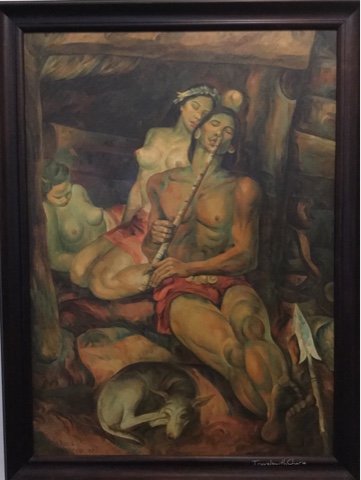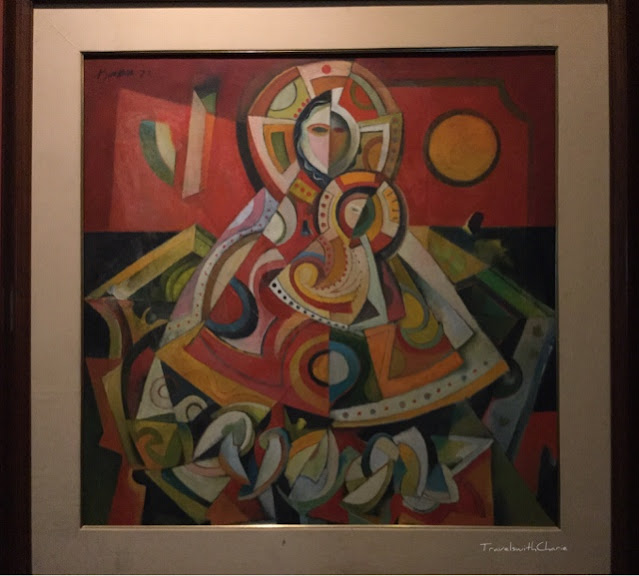 |
| Blast Furnaces of Vizcaya, Juan Luna, 1893 |
I love small museums where I don't have to rush from painting to painting so I can see everything in a few hours. I like to linger, take a photo if it's allowed, leisurely read the attribution card or the brochure and check out the works of art as meticulously as possible. The Yuchengco Museum in Makati is an ideal place to visit and learn about Philippine art in an intimate setting. It wows with its collection of paintings by the masters of Philippine art including Juan Luna, Fernando Amorsolo, Carlos "Botong" Francisco and a host of other artists, some of whom I've included below. During my visit in July, I was lucky to have seen the Benedicto Cabrera Tribute Exhibition, BenCab in Two Movements.
Juan Luna (1857-1899) made a name for himself in 19th century Europe where he was nurtured in the classical style of painting. This education gave birth to such works as the Spoliarium which won him the first gold medal award at the Madrid Exposition of Arts in 1884. There are two paintings by Juan Luna at the Yuchengco Museum, Blast Furnaces of Vizcaya and Interior of Robert Steel Mill. Both of these canvases were commissioned by Martinez de las Rivas who owned the mill. Although Luna's paintings are dark in tone, the appearance of gases from the furnaces remind me of Monet's Gare Saint Lazare series where Monet captured clouds of steam arising from moving trains. Juan Luna lived and worked in Paris from 1884 to 1893 where he was exposed to the Impressionists style of painting and whose lighter palettes influenced his later works such as The Parisian Life (Interior d'un café).
 |
| Mango Harvest, Fernando Amorsolo, 1948 |
 |
| Courtship Ritual, Carlos "Botong" Francisco" 1937 |
“To the poet of Angono, no painter of his time was more closely attuned to the spirit of his land and people." These words were written on the citation given to Botong when he was named National Artist on June 12, 1973. No other painter has done as much for bringing mural painting to the forefront in Philippine art as has Botong.
In Courtship Ritual, Botong presents a man playing a nose flute while all around him, the dog included, have succumbed to sweet slumber. Perhaps the strains from the flute induced this relaxed state of affairs. The women with their bare breasts and the man with his muscular physique and outstretched legs evoke an air of sensuousness which is gently tempered by the languid mood.
 |
| Camote Eaters, Carlos "Botong" Francisco, 1969 |
I had the opportunity to see many of the masterpieces of Botong Francisco (1912-1969) at the Ayala Museum in 2013 when they were celebrating the centennial of Francisco's birthday anniversary. I wrote an article about the exhibition which was called, Botong Francisco, A Nation Imagined and my impressions of some of the paintings that made an impact on me. For more on this exhibition, please check my article here: https://travelswithcharie.blogspot.com/2013/03/botong.html.
 |
| Virgin, Ang Kiukok, 1973, Oil on Canvas |
He once said in an interview that in painting, he felt free. "I can express what I want to say." Ang Kiukok was named National Artist for the Visual Arts in 2001.
 |
| Candle Vendors, Vicente Manansala, 1976 |
Manansala was one of the Thirteen Moderns with Victorio Edades. He also founded the Neo Realist group with Romeo Tabuena and Anita Magsaysay-Ho. He was posthumously awarded the National Artist for Painting Award in 1981.
The Yuchengo Museum is at RCBC Plaza on the corner of Ayala Avenue and Senator Gil J. Puyat in Makati. For more information about the museum, visit their site: https://yuchengcomuseum.org/
If you would like to learn more about the artworks of Carlos Botong Francisco, here are some links to his famous ouevres.
Filipino Struggles in History:
Progress of Medicine in the Philippines:
Masterpieces from the National Museum
Stations of the Cross + 1
*Camote is a sweet potato.
*****
Images by TravelswithCharie